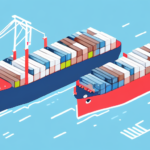5 Ecommerce Shipping Questions to Focus Your Operations
Shipping can make or break an ecommerce business. It's not enough to simply offer competitive prices and great products - if customers don't receive their orders in a timely and efficient manner, they are likely to turn to your competitors. That's why it's essential for ecommerce businesses to prioritize shipping logistics and optimize their operations. Here are five ecommerce shipping questions to help you focus your operations and improve your bottom line.
Why Shipping Should Be a Priority for Ecommerce Businesses
The shipping process is the final touchpoint in the buying journey, and a crucial one at that. It's your opportunity to wow customers with fast delivery, reliable service, and convenient options. In fact, studies have shown that 72% of consumers consider fast shipping options as a critical factor when making a purchase decision (Shopify, 2023). Faster shipping times can lead to improved brand loyalty and repeat purchases. Conversely, poor shipping experiences can lead to negative reviews, lost customers, and a damaged reputation.
One of the biggest challenges for ecommerce businesses is managing shipping costs. However, investing in a reliable and efficient shipping strategy can actually save money in the long run. By negotiating better rates with carriers, optimizing packaging and fulfillment processes, and leveraging technology to streamline operations, businesses can reduce shipping costs by up to 30% (Oberlo, 2023) and improve profitability.
Another important aspect of shipping is transparency and communication with customers. Providing tracking information and updates on delivery status can help build trust and confidence in your brand. Additionally, offering flexible delivery options, such as same-day or next-day delivery, can give customers more control over their purchases and enhance their overall shopping experience.
Understanding the Importance of Shipping Logistics in Ecommerce
Shipping logistics involves the process of planning, implementing, and controlling the movement of goods from the point of origin to the point of consumption. Effective logistics management can help ecommerce businesses streamline their shipping processes, reduce errors, and optimize costs. This includes everything from choosing the right carrier and packaging materials to tracking shipments and handling returns.
One of the key benefits of effective shipping logistics is improved customer satisfaction. When ecommerce businesses are able to deliver products quickly and reliably, customers are more likely to have a positive experience and become repeat customers. In addition, efficient logistics management can help businesses expand their reach by enabling them to offer faster shipping options and reach new markets. This is particularly important in today's competitive ecommerce landscape, where customers expect fast and reliable shipping options.
According to a report by Investopedia, businesses that optimize their logistics can see a 15-20% increase in overall operational efficiency. Leveraging data analytics and inventory management systems can further enhance logistics performance, ensuring that products are available and delivered promptly.
How to Determine the Best Shipping Methods for Your Online Store
There are a variety of shipping methods available to ecommerce businesses, including ground, expedited, and international options. Choosing the right method(s) for your online store depends on a number of factors, such as order volume, weight, destination, customer expectations, and budget. You may also want to consider offering shipping incentives, like free shipping or flat rate options, to increase customer satisfaction and boost sales.
Another important factor to consider when choosing shipping methods for your online store is the type of products you sell. Fragile or perishable items may require special handling or faster shipping options to ensure they arrive in good condition. On the other hand, less time-sensitive items may be able to be shipped using slower, less expensive methods.
It's also important to keep in mind any shipping regulations or restrictions that may apply to your products or destination. For example, certain items may not be allowed to be shipped internationally, or may require special permits or documentation. Make sure to research and comply with any applicable regulations to avoid delays or fines. Resources like the U.S. Trade Administration provide comprehensive guides on international shipping requirements.
Tips for Streamlining Your Ecommerce Shipping Processes
Efficient shipping processes can help reduce costs, improve delivery times, and boost customer satisfaction. To streamline your operations, consider investing in automation tools, like shipping software or label printers, that can streamline your workflows. You can also consider outsourcing some or all of your shipping operations to a third-party logistics (3PL) provider, which can help you save time and resources.
- Implement Shipping Automation: Use software to automate order processing, label generation, and tracking updates.
- Partner with Reliable Carriers: Choose carriers with proven reliability and speed to ensure timely deliveries.
- Optimize Your Inventory Placement: Distribute inventory across multiple warehouses to reduce shipping distances and times.
- Enhance Order Fulfillment: Implement efficient packing techniques and utilize fulfillment centers to speed up processing times.
Another way to streamline your ecommerce shipping processes is to optimize your packaging. Use packaging materials that are lightweight and durable, and choose the right size box or envelope for each shipment to minimize wasted space and reduce shipping costs. You can also consider using eco-friendly packaging materials to appeal to environmentally conscious customers. Additionally, providing tracking information and delivery updates to your customers can help improve their overall experience and reduce the number of customer service inquiries you receive.
The Top Challenges Faced by Ecommerce Businesses in Shipping and How to Overcome Them
Despite the many benefits of ecommerce shipping, there are plenty of challenges that businesses must overcome. These may include issues with carrier reliability, shipping delays, packaging errors, and lost or damaged shipments. To overcome these challenges, it's important to stay on top of your shipping processes and continuously evaluate and optimize them. Consistent communication with carriers, proactive tracking, and proper labeling and packaging can all help mitigate these risks.
Another challenge that ecommerce businesses face in shipping is managing international shipments. Shipping products across borders can be complicated due to varying customs regulations, taxes, and duties. To overcome this challenge, businesses should research and understand the regulations and requirements of each country they ship to. They should also consider partnering with a third-party logistics provider who specializes in international shipping and can help navigate these complexities.
Implementing a robust return policy and process is also essential to handle returns efficiently, which can mitigate customer dissatisfaction and financial loss.
How to Improve Your Shipping Speeds and Meet Customer Expectations
Fast and reliable shipping is a top priority for customers, and for good reason - in today's world, consumers expect their orders to arrive quickly and with minimal hassle. To improve your shipping speeds, you may want to consider partnering with carriers that offer next-day or two-day delivery options. You can also look for opportunities to reduce processing and transit times, such as partnering with local fulfillment centers or utilizing express shipping.
According to a survey by Statista, 54% of consumers are willing to pay more for faster shipping. Investing in faster shipping options can thus not only meet customer expectations but also increase revenue.
Another way to improve your shipping speeds is to optimize your packaging and labeling processes. By using standardized packaging materials and labeling your packages clearly and accurately, you can reduce the time it takes for your shipments to be processed and delivered. Additionally, you may want to consider implementing a real-time tracking system that allows customers to track their orders from the moment they are shipped until they arrive at their doorstep. This can help build trust with your customers and provide them with peace of mind knowing exactly when their package will arrive.
The Role of Technology in Ecommerce Shipping and Why It Matters
Technology has revolutionized the way ecommerce businesses manage their shipping operations. From shipping software to automated labeling and tracking tools, there are a plethora of tech solutions available to help you streamline your workflows and optimize your costs. By leveraging these tools, you can not only improve your shipping processes but also gain valuable insights into customer behavior and preferences.
One of the most significant benefits of using technology in ecommerce shipping is the ability to offer customers more shipping options. With the help of shipping software, businesses can provide customers with real-time shipping rates and delivery estimates, allowing them to choose the option that best suits their needs. This not only improves the customer experience but also helps businesses reduce shipping costs by optimizing carrier selection and package dimensions.
Another advantage of technology in ecommerce shipping is the ability to automate repetitive tasks, such as printing shipping labels and tracking packages. This not only saves time but also reduces the risk of errors and improves accuracy. Additionally, automated tracking tools allow businesses to keep customers informed about the status of their shipments, which can help improve customer satisfaction and reduce the number of customer inquiries related to shipping.
Integrating artificial intelligence and machine learning can further enhance shipping efficiency by predicting shipping delays, optimizing delivery routes, and managing inventory levels based on predictive analytics.
Best Practices for Packaging and Labeling Your Ecommerce Products
Proper packaging and labeling are essential to ensure that products arrive at their destination intact and on time. When packaging your products, consider the fragility and size of each item, as well as the transit time and distance. You should also make sure to include clear and accurate labeling, such as package dimensions, weights, and tracking information, to help carriers and customers easily identify and track your shipments.
Another important aspect to consider when packaging and labeling your ecommerce products is the environmental impact. As consumers become more conscious of their carbon footprint, they are increasingly looking for sustainable and eco-friendly options. You can reduce your environmental impact by using recyclable or biodegradable packaging materials, minimizing excess packaging, and using eco-friendly labeling options. Not only will this help the planet, but it can also attract environmentally conscious customers to your business.
- Use Durable Packaging: Ensure that your packaging can withstand transit without damaging the product.
- Optimize Package Size: Use appropriately sized boxes to reduce shipping costs and minimize waste.
- Include Clear Labels: Provide accurate shipping information and handle-with-care instructions if necessary.
- Incorporate Branding: Use branded packaging to enhance the unboxing experience and reinforce brand identity.
How to Optimize Your Shipping Costs and Save Money on Fulfillment
Shipping costs can quickly add up, especially for business owners with high order volume. By optimizing your shipping processes, you can find ways to reduce costs and save money on fulfillment. This may include negotiating better rates with carriers, choosing more cost-effective shipping methods, or consolidating orders to reduce the number of shipments.
Implementing a zone skipping strategy, where orders are shipped in bulk to a central location before being distributed locally, can significantly decrease shipping expenses. Additionally, leveraging volume discounts with carriers by increasing your shipping volume can lead to substantial savings.
Utilizing a hybrid shipping model that combines multiple carriers and shipping methods based on package size, weight, and destination can also help in minimizing costs while meeting delivery expectations.
The Benefits of Outsourcing Your Ecommerce Shipping Operations
For many ecommerce businesses, outsourcing shipping operations to a third-party logistics (3PL) provider can be a cost-effective and efficient option. 3PL companies specialize in storage, shipping, and distribution, and can help businesses reduce order processing times, improve delivery times, and reduce shipping costs.
- Scalability: Easily scale your shipping operations during peak seasons without the need for additional infrastructure.
- Expertise: Benefit from the logistics expertise and advanced technologies that 3PL providers offer.
- Focus on Core Business: Allow your team to focus on core business activities like marketing and product development.
- Global Reach: Expand your market reach by leveraging the international shipping capabilities of 3PL providers.
Additionally, 3PL providers often offer integrated solutions that include warehousing, inventory management, and returns processing, further streamlining your operations.
How to Provide Excellent Customer Service Through Your Shipping Processes
Shipping is an important touchpoint in the customer journey, and as such, it's crucial to provide excellent customer service throughout the process. This includes providing timely updates on shipments, offering hassle-free returns, and ensuring that packages arrive on time and in good condition. By putting your customers first and prioritizing their needs and expectations, you can build trust and loyalty that will keep them coming back for more.
Here are some strategies to enhance customer service through your shipping processes:
- Real-Time Tracking: Offer customers the ability to track their orders in real-time, providing transparency and peace of mind.
- Clear Communication: Send proactive notifications regarding order status, delays, and delivery confirmations.
- Flexible Return Policies: Implement easy and straightforward return processes to enhance customer satisfaction.
- Personalized Shipping Options: Allow customers to choose their preferred shipping methods and delivery times.
According to PwC, 73% of consumers value customer experience as an important factor in their purchasing decisions. Enhancing your shipping-related customer service can significantly impact your overall customer experience.
Common Mistakes to Avoid When It Comes to Ecommerce Shipping
There are plenty of pitfalls that ecommerce businesses must avoid when it comes to shipping. These may include choosing the wrong carrier, failing to label packages correctly, or overpromising on delivery times. To avoid these mistakes, it's important to stay informed and up-to-date on industry trends and best practices, and to continuously evaluate and optimize your shipping processes.
Here are some common mistakes and how to avoid them:
- Choosing Incompatible Carriers: Ensure that the carriers you select align with your shipping needs and customer expectations.
- Poor Packaging: Invest in quality packaging to prevent damage during transit.
- Incorrect Labeling: Double-check all shipping labels for accuracy to avoid delivery errors.
- Overpromising Delivery Times: Set realistic delivery expectations to maintain customer trust.
- Ignoring Shipping Costs: Monitor and manage shipping expenses to maintain profitability.
Implementing a comprehensive shipping policy and regularly training your team on best practices can help mitigate these common mistakes.
The Future of Ecommerce Shipping: Trends and Predictions
The world of ecommerce shipping is constantly evolving, with new technologies and innovations emerging all the time. Some of the trends that we can expect to see in the years ahead include the use of drones for last-mile deliveries, the adoption of artificial intelligence and machine learning in logistics management, and the increased use of sustainable packaging materials.
Other emerging trends include:
- Autonomous Vehicles: Self-driving delivery vehicles are being tested to reduce labor costs and increase delivery efficiency.
- Blockchain Technology: Enhancing transparency and security in the shipping process through decentralized ledgers.
- Green Logistics: Focusing on environmentally friendly shipping practices to reduce carbon footprints.
- Personalized Delivery Experiences: Offering customized delivery options based on individual customer preferences.
As an ecommerce business owner, it's essential to stay up-to-date on these trends and to continuously evaluate and optimize your shipping processes. By focusing on these key questions and implementing best practices and innovative solutions, you can ensure that your ecommerce business stays ahead of the competition and delivers the best possible customer experience.
For further insights and updates on ecommerce shipping trends, refer to industry reports from reputable sources such as the Forbes Technology Council and the EY Global Consumer Insights.






















